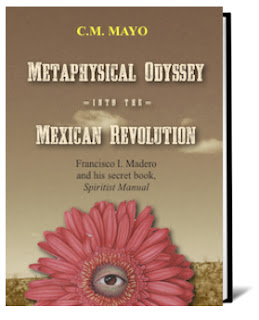

I am the featured member interview this month in the Biographers International newsletter. Herewith:
BIOGRAPHERS INTERNATIONAL: What is your current project and at what stage is it?
C.M. MAYO: I’m at work on World Waiting for a Dream: A Turn in Far West Texas, not a biography properly so-called, but the narrative weaves in some history and so encompasses a number of biographical vignettes from Alvar Nuñez Cabeza de Vaca, the conquistador who got lost, to some of the contemporary artists working in Marfa. Stage: still banging out the first complete draft.

My latest publication, however, is about a major figure of the Mexican Revolution, and that certainly informs the Far West Texas book, for some of the key battles were fought along the US-Mexico border: Metaphysical Odyssey into the Mexican Revolution: Francisco I. Madero and His Secret Book, Spiritist Manual.
Madero was the leader of Mexico’s 1910 Revolution and President of Mexico from 1911-1913, so the fact that he was a Spiritist medium and, albeit under a pseudonym, author of a book of Spiritism published in—yes—1911, is a dramatic twist in the paradigm of how we understand the spark of the Mexican Revolution.
My book, which includes my translation of Madero’s book, was published in 2014, so I am well into the promotion stage. (I’m delighted to report that Metaphysical Odyssey into the Mexican Revolutionwon the National Indie Excellence Award for History, and to date, I’ve given talks about it at Mexico City’s Centro de Estudios de la Historia de México, Rice University, Stanford University, UCSD’s Center for US-Mexico Studies, and the University of Texas El Paso, among other venues.)
> Listen to and/or read some of my talks about this book here.
BI: What person would you most like to write about?
C.M. MAYO: At the moment, because I’m writing about Far West Texas, pioneer petroleum geologist Wallace E. Pratt. I am especially intrigued that he would choose to live for many years in a such an isolated place as McKittrick Canyon, deep in the Guadalupe Mountains. It is, in large part, thanks to Pratt’s visionary gift that we now have the Guadalupe Mountains National Park. I am very honored to say that I will be one of the artists-in-residence in the Guadalupe Mountains National Park this spring, so I will have the chance to retrace his steps and visit his house.
BI: Who is your favorite biographer or what is your favorite biography?
C.M. MAYO: As far as my Far West Texas reading goes, I both admired and especially relished the biography of the 20th century bard of Texas, J. Frank Dobie: A Liberated Mind, by Stephen L. Davis. Many of the popular ideas we take for granted about Texas and Texans have their roots in Dobie’s works.
My two all-time favorite biographies are Nancy Marie Brown’s The Far-Traveler: Voyages of a Viking Woman and Paula Kamen’s Finding Iris Chang: Friendship, Ambition, and the Loss of an Extraordinary Mind.
BI: What have been your most satisfying moments as a biographer?
C.M. MAYO: I’ll answer this for my book on Francisco I. Madero, Metaphysical Odyssey into the Mexican Revolution. After many years of reading and archival research, it was tremendously satisfying to be able to fit together the pieces of what had been a humdinger of a puzzle—how could Madero be rifle-toting revolutionary and a Spiritist, a savvy political organizer and victim of a coup d’etat?— into a narrative of high strangeness but relative sense. Suddenly Mexico itself looked very different.
BI: One research/marketing/attitudinal tip to share?
C.M. MAYO: As a biographer I have only published the one title, however, I have published several other works of fiction and nonfiction, so I do have more than a little experience about this perennially mystifying and consternating topic.
My short answer is three words: sports psychology helps.
My long answer is: take consistent resilient actions, answer the email that deserves an answer, write an op-ed if you can, and be generous (what goes around comes around, albeit willynilly). The true reward is in the writing itself. It is a wondrous privilege to be able to write at all. Don’t ignore the “publishing business,” but don’t take it too seriously, either. Books can have deeply strange destinies. After all, they are magical time travelers.
BI: What genre, besides biography, do you read for pleasure and who are some of your favorite writers?
C.M. MAYO: I mainly read history, literary essay, and literary fiction. Just this year I’ve come across several historians who are my new favorites: Patricia Nelson Limerick (The Legacy of Conquest: The Unbroken Past of the American West); Jill Lepore (The Name of War: King Philip’s War and the Origin of American Identity); and Rebecca Solnit (River of Shadows: Eadweard Muybridge and the Technological Wild West).
For literary essay I remain in awe of V.S. Naipaul, in particular, his memoir published in 1989, A Turn in the South. This year I especially admired Shelley Armitage’s Walking the Llano: A Texas Memoir of Place and, last year, one of my favorite writers writing on Mexico, Sam Quinones, brought out Dreamland: The True Tale of America’s Opiate Epidemic— a grenade of a book, a must read for anyone and everyone living anywhere in North America.
Fiction: Agustín Cadena, Truman Capote, Willa Cather, Anton Chekhov, Giuseppe di Lampedusa, Ann Patchett, Leo Tolstoy, Edith Wharton.

The Strangely Beautiful Sierra Madera Astrobleme
Find out more about
C.M. Mayo’s books, articles, podcasts, and more.


